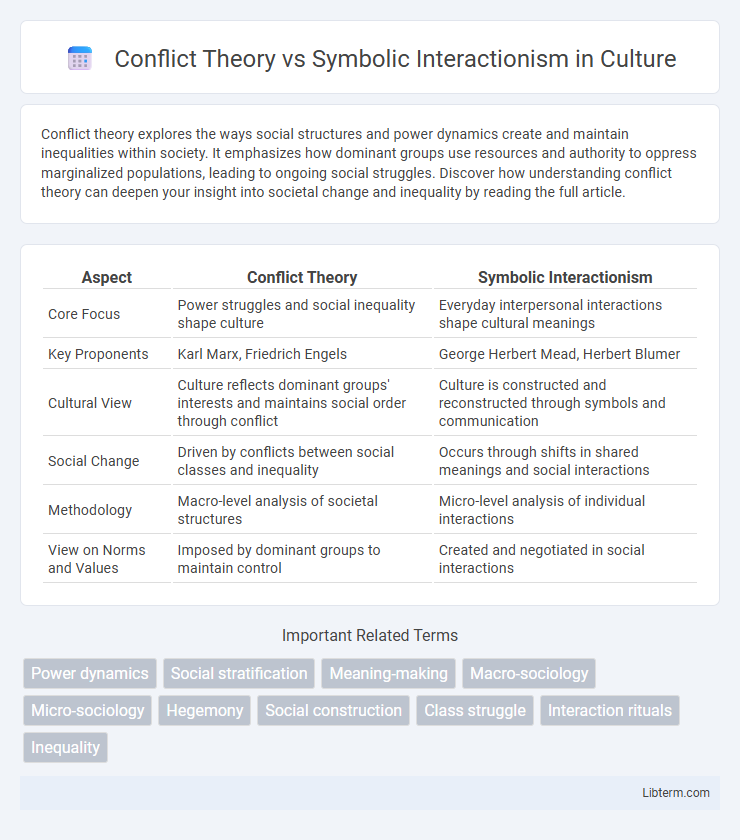Conflict theory explores the ways social structures and power dynamics create and maintain inequalities within society. It emphasizes how dominant groups use resources and authority to oppress marginalized populations, leading to ongoing social struggles. Discover how understanding conflict theory can deepen your insight into societal change and inequality by reading the full article.
Table of Comparison
| Aspect | Conflict Theory | Symbolic Interactionism |
|---|---|---|
| Core Focus | Power struggles and social inequality shape culture | Everyday interpersonal interactions shape cultural meanings |
| Key Proponents | Karl Marx, Friedrich Engels | George Herbert Mead, Herbert Blumer |
| Cultural View | Culture reflects dominant groups' interests and maintains social order through conflict | Culture is constructed and reconstructed through symbols and communication |
| Social Change | Driven by conflicts between social classes and inequality | Occurs through shifts in shared meanings and social interactions |
| Methodology | Macro-level analysis of societal structures | Micro-level analysis of individual interactions |
| View on Norms and Values | Imposed by dominant groups to maintain control | Created and negotiated in social interactions |
Introduction to Conflict Theory and Symbolic Interactionism
Conflict Theory emphasizes social inequalities and power struggles as fundamental drivers of societal change, highlighting how dominant groups maintain control over resources and institutions. Symbolic Interactionism focuses on micro-level interactions and the meanings individuals assign to symbols, shaping social reality through communication and shared understanding. Both theories provide distinct analytical lenses: Conflict Theory examines macro-structural forces, while Symbolic Interactionism explores everyday social interactions.
Historical Origins of Each Theory
Conflict Theory originated in the mid-19th century, heavily influenced by Karl Marx's analysis of class struggle and economic inequalities during the Industrial Revolution, emphasizing power dynamics and societal conflicts. Symbolic Interactionism emerged in the early 20th century from the work of George Herbert Mead and Herbert Blumer, rooted in pragmatism and focusing on micro-level social interactions and the meanings individuals assign to symbols. Both theories address social structures, but Conflict Theory centers on macro-level power disparities, while Symbolic Interactionism investigates everyday communication and subjective experiences.
Core Principles of Conflict Theory
Conflict Theory centers on the idea that society is shaped by power struggles and inequality, emphasizing the role of social classes competing for resources. It views social order as maintained by dominance and coercion rather than consensus, highlighting conflicts between the bourgeoisie and proletariat. This theory contrasts with Symbolic Interactionism, which focuses on micro-level social interactions and shared meanings rather than structural inequalities.
Fundamental Concepts of Symbolic Interactionism
Symbolic Interactionism centers on the fundamental concept that individuals create and interpret meanings through social interactions, emphasizing the role of symbols, language, and gestures in shaping human behavior. Unlike Conflict Theory, which focuses on power struggles and inequalities, Symbolic Interactionism explores how people construct reality through daily exchanges and shared understandings. This theory highlights the dynamic process of identity formation and social roles as fluid and continuously negotiated within social contexts.
Key Theorists and Contributions
Conflict theory, prominently advanced by Karl Marx, emphasizes societal power struggles and class conflicts as driving forces behind social change, highlighting economic inequality and exploitation. Symbolic Interactionism, rooted in the work of George Herbert Mead and further developed by Herbert Blumer, explores how individuals create and interpret social reality through everyday interactions and the use of symbols. Marx's analysis of class conflict contrasts with Mead's focus on micro-level social processes, offering complementary perspectives on societal dynamics.
Approaches to Social Structure and Power
Conflict Theory emphasizes the role of power struggles and inequality in shaping social structures, highlighting how dominant groups maintain control through economic, political, and social means. Symbolic Interactionism focuses on the micro-level analysis of social interactions and the meanings individuals attach to these interactions, revealing how social power is negotiated and constructed through language and symbols. Both approaches provide distinct perspectives on how power dynamics influence social order, with Conflict Theory addressing macro-level power imbalances and Symbolic Interactionism exploring the fluid and interpretive nature of social power at the individual level.
Perspectives on Inequality and Social Change
Conflict theory views social inequality as a result of power struggles between dominant and subordinate groups, emphasizing class conflict and systemic oppression as drivers of social change. Symbolic interactionism focuses on how individuals create and maintain social inequality through daily interactions, symbols, and meanings, highlighting the micro-level processes that reinforce or challenge social norms. Both perspectives provide critical insights into the mechanisms of inequality, with conflict theory stressing structural transformation and symbolic interactionism underscoring the role of social perceptions in shaping societal dynamics.
Methods of Analysis and Research
Conflict Theory utilizes macro-level quantitative methods such as surveys and statistical analysis to examine power disparities and resource inequalities within social structures. Symbolic Interactionism employs micro-level qualitative approaches including participant observation and in-depth interviews to analyze everyday interactions and the construction of social meanings. Research in Conflict Theory emphasizes systemic change, while Symbolic Interactionism focuses on individual experiences and subjective interpretations.
Real-World Applications and Examples
Conflict Theory explains social dynamics through power struggles and inequalities, exemplified by labor strikes where workers demand fair wages against corporate interests. Symbolic Interactionism analyzes everyday interactions and the meanings individuals assign, as seen in how social media users create identities through shared symbols and language. In education, Conflict Theory highlights disparities in resource allocation, while Symbolic Interactionism examines teacher-student communication patterns shaping classroom experiences.
Comparative Analysis: Strengths and Limitations
Conflict Theory excels in highlighting power dynamics and social inequalities, offering a macro-level perspective that explains systemic issues like class struggles and institutional oppression. Symbolic Interactionism provides a micro-level analysis by exploring everyday social interactions and the meanings individuals assign to symbols, enriching understanding of identity and social behavior. However, Conflict Theory may overlook individual agency and nuanced interpersonal processes, while Symbolic Interactionism can underemphasize broader structural forces shaping society.
Conflict Theory Infographic

 libterm.com
libterm.com